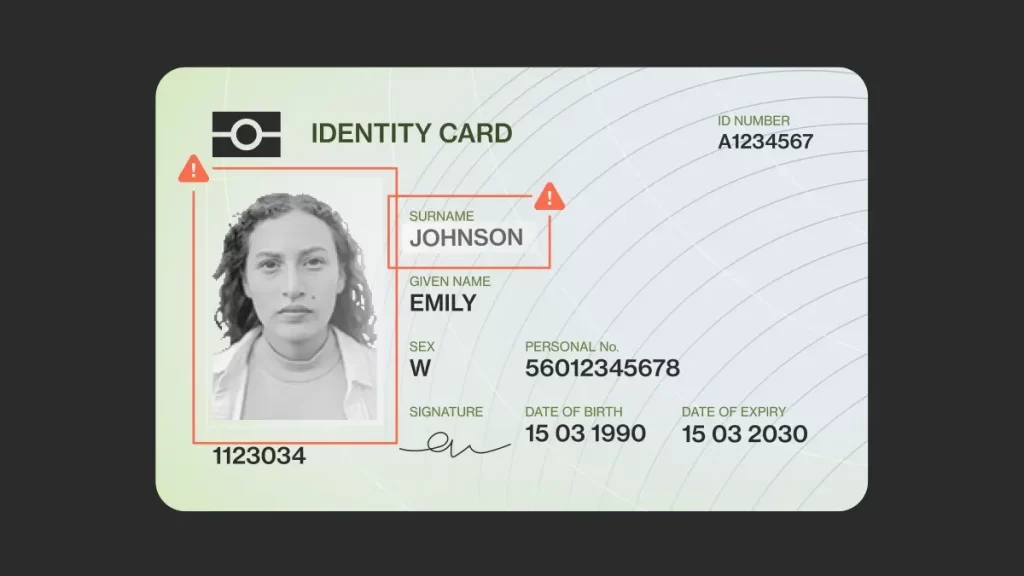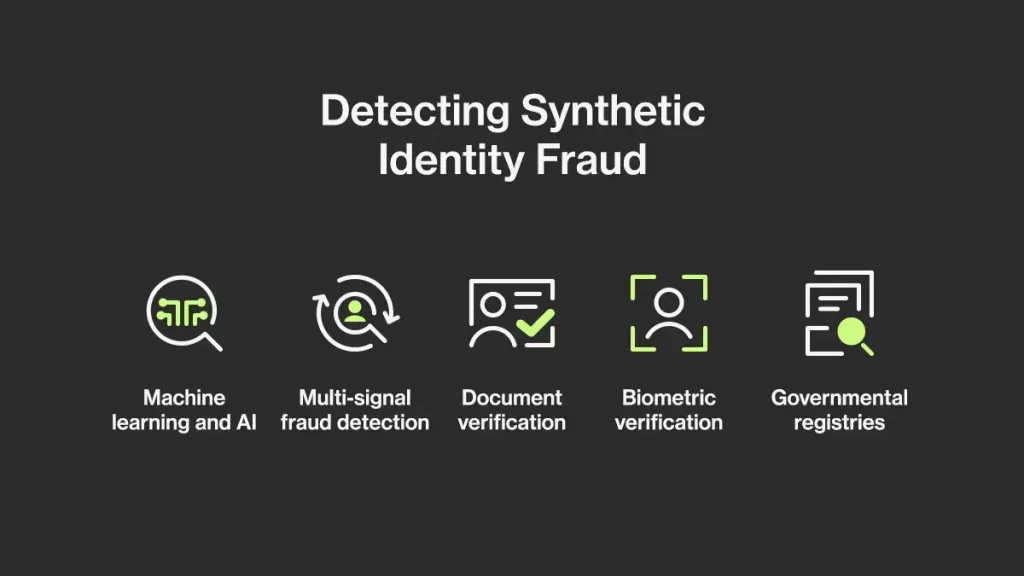Synthetic identity fraud is an escalating concern in the world, with traditional fraud detection methods proving insufficient. This blog explores the nature of synthetic identity fraud, its impact, and why businesses must adopt new strategies for fraud prevention.
Synthetic Identity Fraud: Definition and Explanation

Synthetic identity fraud occurs when criminals blend fake and real information found through data breaches, such as Social Security Numbers (SSNs) and names to fabricate a new identity. This false identity is then used to defraud financial institutions, government agencies, or individuals by opening fraudulent accounts and making illegitimate purchases.
This type of fraud is particularly prevalent in the US due to the heavy reliance on personally identifiable information (PII) like SSNs for identity verification.
Detecting synthetic identity fraud is more challenging than traditional identity theft because victims often include individuals who rarely check their credit information, such as children, the elderly, or the homeless. Fraudsters typically develop these synthetic identities over time, steadily applying for credit and building a positive payment history before eventually maxing out the credit and disappearing. This prolonged nurturing of fake identities allows them to commit financial fraud while remaining unnoticed for extended periods.
The Mechanics of Synthetic Identity Theft
Synthetic identity theft works by combining real and fabricated identity details to create accounts or make purchases fraudulently. The genuine information, often stolen (e.g., photos, SSNs, date of birth), is mixed with fake details like fictitious names, addresses and more. Fraudsters then use this synthetic identity to open credit cards or make fraudulent transactions, earning the nickname „Frankenstein identity” for the way it pieces together various bits of information.
Initially, a fraudster might use the synthetic identity to open accounts or perform actions that build up credit and credibility. Once they appear to be highly qualified, low-risk borrowers, they make large fraudulent purchases or take out substantial loans before disappearing. The potential for large financial gains and the ability to evade detection make synthetic identity fraud appealing to criminals and crime rings. It represents a sophisticated level of fraud executed by highly skilled identity thieves.
Synthetic identities are tough for basic fraud detection systems to identify because they incorporate elements of real identity. Businesses must employ identity proofing services with robust, multi-layered fraud detection capabilities to identify synthetic identity theft. As digital transactions and online activities increase, so does the incidence of online fraud across various sectors, including traditional banking and cryptocurrency.
Fraudsters typically create synthetic identities using two main methods:
Manipulated Identities
In order to commit synthetic identity fraud, fraudsters alter one or more personal details of a genuine identity. For instance, a consumer with a poor credit history might manipulate their identity to conceal their past. These manipulated synthetic identities are often easier to detect.
Manufactured Identities
Here, fraudsters combine real and fake information to create a new identity. For example, they might use a mix of authentic and false details to open an account that doesn’t correspond to any real person.
The Impact of Synthetic Identity Fraud
Synthetic identity fraudsters have a big impact on the financial system as this type of identity theft harms both businesses and individuals.
Impact on Businesses
Synthetic identity fraud has a profound impact on businesses, particularly financial institutions. Businesses lose billions of dollars annually to this type of fraud, primarily through unpaid debts incurred by fraudulent accounts. When a synthetic identity is used to obtain credit, businesses extend lines of credit and loans to individuals who essentially do not exist. This results in significant financial losses when the fraudsters default on these loans. Additionally, businesses incur substantial costs related to fraud detection and prevention measures, as they must continuously invest in advanced technology and processes to combat this evolving threat.
Moreover, synthetic identity fraud undermines the trust between businesses and their customers. As companies struggle to manage and mitigate fraud, customers may lose confidence in their ability to protect personal information, leading to reputational damage and loss of clientele. Businesses also face regulatory penalties if they fail to comply with financial crime prevention regulations, adding another layer of financial and operational burden.
Impact on Individuals
For individuals, synthetic identity fraud can have devastating and long-lasting effects. A victim of synthetic identity fraud will often include vulnerable populations such as children, the elderly, and the homeless, whose Social Security Numbers (SSNs) are stolen and used to create synthetic identities. These individuals may not realise their personal information has been compromised until they apply for credit or loans, only to discover their credit history has been wrecked by fraudulent activity.
This type of identity manipulation can lead to a range of financial problems for the victims, including damaged credit scores, denial of loans or credit applications, and the lengthy process of proving their true identity and rectifying their credit reports. The emotional toll is also significant, as individuals must navigate the stress and frustration of resolving these issues, which can take years to fully address.
Furthermore, synthetic identity fraud creates a ripple effect that impacts society at large. As more individuals fall victim to this crime, the overall trust in financial systems diminishes, leading to increased scrutiny and tighter regulations. This, in turn, can result in more stringent credit approval processes and higher costs for consumers and businesses alike.
How to Detect Synthetic Identity Fraud
Detecting synthetic identity fraud requires multiple approaches. One fundamental method is leveraging machine learning (ML) and artificial intelligence (AI) to analyse customer behaviour patterns and identify anomalies. Additionally, businesses can cross-reference various data sources, including third-party data, across accounts, portfolios, and organisations to uncover inconsistencies.
Investing in advanced identity verification methods, such as document and biometric verification powered by AI algorithms, is crucial. While synthetic identities that combine real SSNs with fake data can often pass credit bureau checks, they are less likely to survive thorough document verification. Fraudsters typically cannot produce genuine identity documents that match their synthetic identities.
Incorporating government-verified data is also essential. For example, the US government’s eCBSV (Electronic Consent Based Social Security Number Verification) service helps combat synthetic identity fraud by matching names, birthdates, and Social Security Numbers, and providing death indicators.
Avoiding synthetic identity fraud requires businesses to adopt sophisticated identity verification methods. Here are some effective strategies:

Machine learning and AI: Utilise these technologies to understand customer behaviour patterns and spot anomalies.
Multi-signal fraud detection: Analyse and connect various data points across accounts and organisations.
Document verification: Require fraudsters to submit identity documents, making it harder for synthetic identities to pass checks.
Biometric verification: Use biometric data, such as facial recognition or fingerprints, to verify identities.
Governmental registries: Leverage government validation services like eCBSV to match identity attributes and detect fraud.
How to Prevent Synthetic Identity Fraud
Automated ID verification stands out as the most effective method to reduce identity fraud and catch fraudsters. Traditional manual verification processes are not only time-consuming but also labour-intensive, making them less efficient and prone to human error. In contrast, automated solutions like Ondato’s service streamline the verification process, enabling rapid client onboarding while simultaneously detecting sophisticated spoofing attempts, such as the use of masks or document alterations.
By integrating Ondato’s automated biometric identification tool, organisations can delegate the heavy lifting to a smart and reliable system. This not only saves time and enhances performance but also ensures a higher level of safety and accuracy in fraud detection. The use of advanced technology in automated ID verification helps in maintaining compliance with financial regulations and protects businesses and their customers from the detrimental impacts of synthetic identity fraud.

Last Thoughts
Synthetic identity fraud is a significant and growing threat. Businesses must move beyond traditional verification methods and adopt more advanced techniques to protect against this sophisticated type of fraud. By implementing robust, multi-layered fraud prevention strategies, businesses can better safeguard their operations and their customers’ identities.



